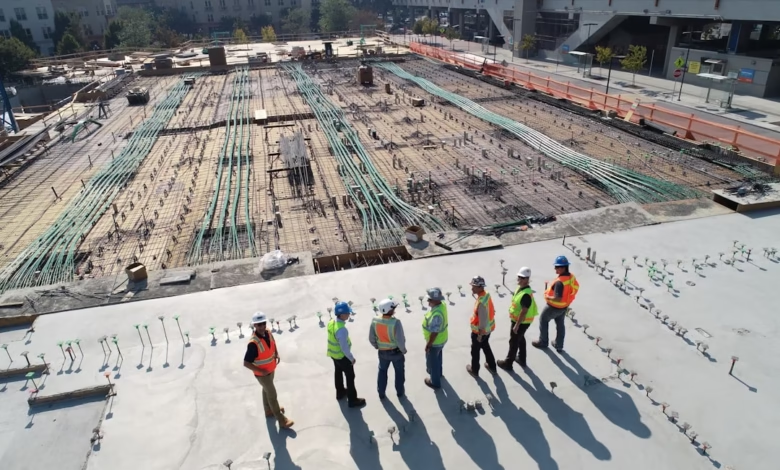Exploring Construction Metals: The Impact of Steel, Aluminum, and Innovations in Sustainable Metal Production

In the ever-evolving landscape of modern construction, metals play a pivotal role that extends beyond mere structural integrity. From the robust strength of steel to the lightweight versatility of aluminum, construction metals are essential components that influence both the design and functionality of buildings. As we delve into the world of ferrous and non-ferrous metals, it becomes clear that understanding their properties and applications is crucial for architects, builders, and investors alike. This article will explore the role of industrial metals, such as copper, zinc, and precious metals like gold and silver, in shaping today’s construction industry.
Furthermore, the shift towards sustainable metal production is gaining momentum, with innovations in metal recycling and fabrication practices paving the way for a greener future. By examining these advancements, we can appreciate how they contribute to reducing waste and enhancing the efficiency of metal mining.
Lastly, we will venture into the future of construction metals, highlighting emerging trends in metal alloys and the impact of technologies like 3D printing metals. As the industry adapts to new demands and challenges, understanding these trends will be essential for navigating the complexities of metal commodities and their applications in various sectors, including aerospace and automotive industries. Join us as we uncover the intricate relationship between construction metals and the future of building materials.
- 1. The Role of Ferrous and Non-Ferrous Metals in Modern Construction: Understanding Steel and Aluminum
- 2. Sustainable Metal Production in Building Materials: Innovations in Metal Recycling and Fabrication
- 3. Exploring the Future of Construction Metals: Trends in Metal Alloys and Their Impact on the Industry
1. The Role of Ferrous and Non-Ferrous Metals in Modern Construction: Understanding Steel and Aluminum
In modern construction, the significance of both ferrous and non-ferrous metals cannot be overstated. Ferrous metals, predominantly steel, are known for their strength and durability, making them a staple in structural applications. Steel’s outstanding properties stem from its metallurgy, which involves the manipulation of iron and carbon to create various metal alloys tailored for different construction needs. This versatility allows steel to be used in everything from beams and columns to reinforcing bars, providing the backbone for many infrastructure projects.
On the other hand, non-ferrous metals like aluminum play a crucial role in modern building materials. Aluminum is lightweight, resistant to corrosion, and possesses excellent thermal and electrical conductivity, making it ideal for applications in windows, doors, and roofing. Its recyclability also supports sustainable metal production, aligning with the growing emphasis on environmental responsibility in construction. The ability to recycle aluminum not only conserves energy but also reduces the demand for raw metal mining, contributing to a circular economy.
Both ferrous and non-ferrous metals are integral to construction, but they serve different purposes. For instance, while steel is favored for its strength in load-bearing applications, aluminum is often chosen for its aesthetic appeal and lightweight properties. In addition to these two, other base metals like copper and zinc are utilized in various aspects of construction, such as electrical wiring and roofing materials.
As trends in construction evolve, the integration of advanced technologies like 3D printing metals is gaining traction. This innovation allows for precise fabrication of metal components, reducing waste and enhancing design flexibility. Furthermore, the emergence of battery metals such as lithium and rare earth metals underscores the growing intersection between construction and energy sectors, especially in developing sustainable buildings that utilize renewable energy sources.
In conclusion, understanding the roles of ferrous and non-ferrous metals is essential for anyone involved in the construction industry. As we navigate the future of building materials, focusing on the properties, applications, and sustainability of these metals, including the recycling potential and advancements in metallurgy, will be vital for creating resilient and eco-friendly structures.
2. Sustainable Metal Production in Building Materials: Innovations in Metal Recycling and Fabrication
Sustainable metal production has become a vital focus in the construction industry, driven by the need to minimize environmental impact while meeting the growing demand for building materials. Innovations in metal recycling and fabrication are playing a crucial role in this shift towards sustainability.
One of the most significant advancements is the enhancement of metal recycling processes, which allows for the recovery and reuse of ferrous and non-ferrous metals, such as steel, aluminum, copper, and zinc. By recycling these base metals, the construction sector reduces reliance on metal mining, which is often associated with significant ecological disruption. For instance, the recycling of aluminum not only conserves energy—up to 95% less than producing new aluminum from ore—but also decreases carbon emissions considerably.
In addition to traditional recycling methods, innovative techniques like 3D printing metals are emerging. This technology allows for the precise fabrication of metal alloys from recycled materials, minimizing waste and enabling the creation of complex structures that were previously difficult to achieve. As the demand for construction metals increases, these advancements in metallurgy and metal fabrication are essential for ensuring that the industry can sustainably produce the materials needed.
Moreover, the focus on sustainable metal production extends to precious metals and rare earth metals, which are critical in various applications, including electronics and renewable energy technologies. For example, lithium and battery metals are essential for energy storage solutions, which are vital for the transition to renewable energy sources. By utilizing recycled materials in the production of these metals, the construction and automotive industries can significantly reduce their environmental footprint.
As the market for metal commodities evolves, trends in sustainable practices, including the use of refractory metals and automotive metals, are becoming increasingly important. Companies are investing in technologies that not only improve efficiency but also enhance the durability of metals, addressing issues like metal corrosion. This proactive approach not only benefits the environment but also supports gold investing and silver investing, as investors seek companies committed to sustainable practices.
In conclusion, the future of construction metals lies in the continuous innovation of sustainable metal production methods. By embracing metal recycling and advanced fabrication techniques, the industry can meet the demands for high-quality materials while also fostering a more sustainable environment.
3. Exploring the Future of Construction Metals: Trends in Metal Alloys and Their Impact on the Industry
The construction industry is undergoing a significant transformation, with innovations in metallurgy and metal alloys leading the way. As we explore the future of construction metals, several key trends are emerging that will impact the way we utilize ferrous and non-ferrous metals in building materials.
One of the most notable trends is the increasing use of advanced metal alloys. These alloys, which combine various base metals such as steel, aluminum, copper, and zinc, offer enhanced properties such as improved strength, corrosion resistance, and lightweight characteristics. For instance, aluminum alloys are becoming more prevalent in construction due to their high strength-to-weight ratio and resistance to metal corrosion, making them ideal for both structural and aesthetic applications.
Sustainable metal production is another critical trend shaping the future of construction metals. As the industry moves toward greener practices, there is a growing emphasis on metal recycling. This not only reduces waste but also conserves precious metals and industrial metals, minimizing the need for extensive metal mining. Recycled metals offer the same performance characteristics as newly mined materials, ensuring that construction projects maintain their integrity while being environmentally responsible.
Additionally, the rise of 3D printing metals is revolutionizing the way construction components are fabricated. This technology allows for precise customization of metal parts, reducing material waste and enabling the creation of complex structures that were previously difficult to achieve. The incorporation of energy metals, like lithium and copper, in 3D printed components is also paving the way for innovative applications in energy-efficient buildings.
Moreover, as we delve into the realm of metal commodities, investors are increasingly looking at gold and silver investing, particularly in relation to their industrial applications. Precious metals like platinum and palladium are gaining traction in construction for their unique properties and resistance to corrosion, making them valuable for specific applications.
In summary, the future of construction metals is bright, driven by advancements in metal alloys, sustainability initiatives, and cutting-edge technologies such as 3D printing. As the industry continues to evolve, staying abreast of these metal trends will be crucial for professionals seeking to optimize their projects and embrace innovative solutions.
In conclusion, construction metals such as steel and aluminum play a pivotal role in modern building materials, providing essential strength and durability to structures. As we have explored, both ferrous and non-ferrous metals are integral to the construction industry, each offering unique benefits that cater to various applications. The push for sustainable metal production has led to innovative practices in metal recycling and fabrication, addressing environmental concerns while enhancing the efficiency of metal usage in construction projects.
Looking ahead, the future of construction metals is bright, with advancements in metallurgy and the development of new metal alloys promising to transform the industry. Trends in the utilization of base metals, rare earth metals, and even precious metals like platinum and palladium could redefine construction standards, particularly in energy-efficient and sustainable building practices.
As the construction industry continues to evolve, embracing technologies such as 3D printing metals and exploring the potential of battery metals will be crucial in meeting the demands of a changing world. By prioritizing sustainable practices and innovative solutions, stakeholders can ensure that construction metals not only meet the needs of today but also contribute to a more sustainable future. Whether through gold investing, silver investing, or focusing on industrial metals like copper and zinc, the smart use of metals in construction will remain a critical component in shaping resilient and sustainable infrastructure.
References:
[Include all sources used in the article here, following APA citation style]




